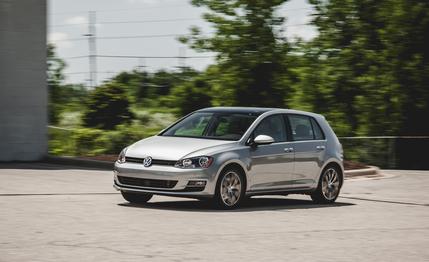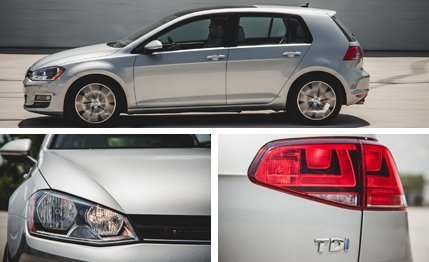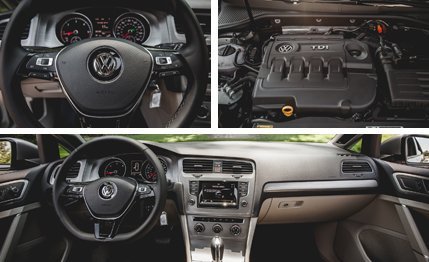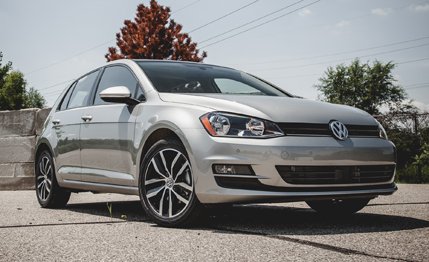 Instrumented Test
Instrumented Test
Once upon a long-ago oil crisis, the VW Golf was Germany’s cubic answer to OPEC and the Honda CVCC. Those of you accustomed to thinking of it as the cheap little heir to the Rabbit, itself the heir to the original hippy-tippy Beetle, need to get up and adjust the rabbit ears on your signal receiver. Nowadays, VW is out of the cheap-car business and the punched-out, buffed-up, brushed-metal-trimmed 2015 Golf is a Mercedes-Benz with the trunk hacked off. Go for the 2.0-liter EA288 TDI diesel, just becoming available next month, and you can revel in this hatchback’s epicurean comforts for more than 450 miles between pit stops.
Upon first glance at the spec sheet, the TDI’s 13.2-gallon fuel tank seems a cruel joke, until you start driving and the fuel-gauge needle resolutely refuses to budge. Drive some more, and some more, and a bit more, and then just a bit farther, and it finally lifts off the full line, from which it sweeps very, very slowly, like the hour hand of Big Ben (if Big Ben went backward), to the half-way mark. Then the needle picks up a bit of speed, and finally gets its wind up by the quarter-tank mark, suddenly dropping to E with the kinetic energy of a plummeting boat anchor.
Diesel-Only, Dummkopf
All the while, the 150-hp TDI putters away with such smooth refinement and such a distant and muted diesel growl that the author’s mother, who once owned a 1982 Chevy Caprice Classic diesel and breaks out in hives at the thought of even accepting a package from the driver of a diesel delivery van, refused to believe that this Golf TDI runs on diesel. She had to be shown the fuel door, behind which it says “Diesel ONLY, Dummkopf!” in about 15 places. Plus, there is a second blue filler cap for the AdBlue diesel clean-juice. Should you accidentally fill your TDI with gasoline, the car sends a signal to Germany and you are denied future entry to the country on the grounds of being an idiot and a menace to the nation’s rental-car fleet.

In our hands, the roomy and comfortable Golf TDI equipped with a six-speed dual-clutch automatic averaged 34 mpg, a good result given that we tend not to drive with economy in mind. You’d have to get into a much smaller gasoline car or an equally expensive hybrid to match this fuel efficiency. We can even see sane people getting routinely close to 40 mpg. The TDI’s 60-mph mark comes in 7.8 seconds and the quarter-mile in 16.1 on strong low- and midrange urge from the engine’s 236 lb-ft of torque. Those are very acceptable numbers in times when everybody is driving much too fast—except for all the morons who are driving way too slow. At 80 mph, the Golf TDI is in a very happy and stable groove, the cabin remaining plush and quiet and free from wind noise. But push past 80 clicks (pretend you’re in Germany) and the engine begins to audibly strain.
Throw it into a cloverleaf and there’s 0.86-g worth of roadholding from the wide, deluxe Continetnal ContiProContact tires. This 3237-pound Golf has plenty of suspension travel for taming rough stuff, but the body doesn’t wallow in a high-g turn, as did some previous Golfs. The strong structure kills vibrations and road thrum, and the Golf has that solid German highway composure that makes traveling to Oma’s house in Oberbayern such a secret pleasure.
The Price of Frugality
The diesel’s thrift comes at a price, however. The premium for the TDI over a gasoline TSI engine in our tested SE trim, DSG (TDI) to torque-converter automatic (TSI), is $2100. Six-speed manual transmission TDIs are available in the SE and the higher-spec SEL range, but no manuals are offered in those trims in the gasoline TSI version, so direct price comparisons there are impossible.

However, if you’re thinking of being frugal and gunning for an entry-level three-door Golf S manual, then VW nails you. The upcharge from the TSI S manual to the TDI S manual is a vengeful $3000, although you also get larger 16-inch wheels with that. That puts the TDI base prices as follows: S manual, $22,815; SE manual, $26,315; SE DSG (our test car), $27,415; and the Eldorado of Golf diesels, the SEL, at $28,815 (add $1100 for an automatic). So that makes the $23,315 base S five-door model the least-expensive Golf TDI with the DSG automatic.
Ultimately, with VW’s diesel-engine surcharge and U.S. diesel-fuel prices being generally the same or higher than gasoline, you may want to view the 500-mile cruising range of the TDI as you would a convenience option, such as a sunroof, sport package, or fancy stereo. Unless you routinely drive long distances, though, it’s going to take quite a while for the TDI to earn back its premium, so don’t buy one thinking you’ll necessarily save money. And whatever you do save may be forgotten every time you—running on fumes—pull into a station only to discover that it doesn’t serve diesel.
The Golf TDI’s big price leap is from S to SE trim, which buys you a sunroof, 17-inch wheels, and a lot of electronic conveniences such as rain-sensing wipers, heated seats, and a rearview camera. The seats remain “leatherette,” but it’s very nice leatherette. You do not get automatic climate control, which won’t bother some, but in fine Euro-car tradition, the Golf’s A/C takes its time chilling a hot cabin.
Putting Out a Nice Spread
The Golf’s evolution into a pseudo luxury liner has been afoot for some time, but with this seventh-gen Golf, which debuted for 2015, it reaches even more inflated dimensions. The Golf VII is a good two inches longer than its predecessor and, at more than 70 inches wide, is a rather extravagant driveway consumer. Just park a Golf IV next to a VII to see how portly VW’s once-little duffer has become over the past decade. The upside is a vastly more spacious cabin, with lots of empty air now filling the gaps between you, the passengers, and the doors. The Golf VII is a smallish car designed to feel positively huge inside.

Inside an SE, it’s all very serious and high-dollar, with a cockpit oriented toward the driver and brushed-metal-like trim stretching across the gauges and splashing down the center console. There isn’t this much naked stainless in Wolfgang Puck’s kitchen, and we’re not sure whether we should be driving the new Golf or preparing dinner for a bar mitzvah at the Spielbergs’.
All this bare brightwork is a bit of a cliché nowadays—the slabs-o-metal ship has sailed, boys—and does not make the car feel current or sporty. In fact, it reminds us of old Rolex watches on old men’s wrists and of Toyota’s recent utter obsession with metalized trim, which is definitely not a compliment. If this is VW’s youth car, it needs some more youthful ideas in the cabin. See the Chevy Sonic and Spark for outside-the-faux-metal-box thinking.
Nonetheless, if you think a $31,000 Mercedes-Benz CLA sedan is silly when you can instead have a more practical hatchback body type with Benz-like trimmings and diesel economy, all for a bit less money than a CLA, then the Golf TDI SE is growling your name.